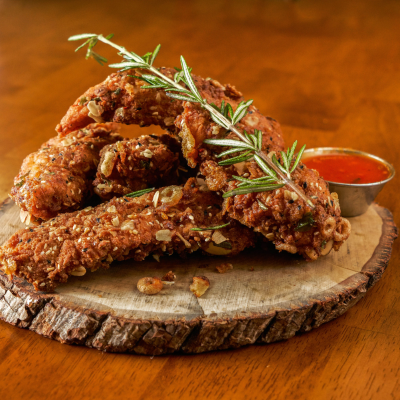When it’s time to fix school lunches, there’s nothing more challenging than striking the right balance between preparing nutritious meals and snacks and packing foods the kids will actually want to bring to school and eat. To explore some recipes that offer the best of both worlds, I reached out to chef Dante Gonzales for his take on healthy, kid-friendly recipes perfect for packing in a lunch box.
Gonzales is the owner and head chef of Dante Fried Chicken (DFC), which he initially launched in 2001 in Brooklyn as a catering company hosting eclectic dinner parties and running an underground delivery service. It was during these private dinner parties that Gonzales started introducing vegetarian and vegan alternatives to popular food dishes. “I served free granola-fried tofu nuggets,” he recounts. “Partygoers didn’t even realize the ‘chicken’ was plant-based.”
DFC is now an L.A.-based food truck or, as Gonzales puts it, “a roaming fried chicken (and tofu) concert.”Born and raised in L.A. for the first 10 years of his life, Gonzales has also lived in Seattle, St. Louis, Phoenix, Chicago, London and Stockholm. And while this diversity in geographies has impacted his worldview, Gonzales credits his family — rich with many skilled cooks and a grandmother who is a professionally trained chef — for influencing his decision to pursue a career in the culinary arts. “My grandmother’s Southern and Creole heritage is a core influence on my cooking,” says Gonzales, who began his own career working as a full-time chef while he was in college.
“Cooking is in my DNA,” he says. “I often cook proteins like gumbo and fried chicken, along with vegetables such as beets, collards, green leaf salad and sautéed cabbage.”
In addition to his DFC food truck and events, Gonzales wrote and published a cookbook, “Ride or Fry: The Dante Fried Chicken Experience,” and many of the book’s recipes are vegetarian and vegan-friendly. His “Tomatillo Collard Greens” is one example. They taste “like traditional greens with smoked bacon and turkey neck, except they’re vegan,” Gonzales says. His philosophy is to prepare vegetables without using animal fats. In the collard greens recipe, for instance, he smokes cherry tomatoes to attain that desired smoky bacon flavor in the collards.
Gonzalez also works at Moonwater Farm’s summer camp program in Compton, making delicious and nourishing vegetarian meals from the produce grown at the farm. Moonwater Farm aims to promote sustainability, community and connection through engaging with farming and agricultural practices. Gonzales was inspired by the farm’s co-creator, Kathleen Blackistone, and her aim to serve the Compton area.
Moonwater Farm believes in a “veggie-forward concept and nutrition,” Gonzales explains. “The kids enjoy foraging the garden for berries, veggies and fruit, which we prepare together.”
Although the children enjoy being involved in the cooking process, Gonzales says, “it can be challenging to introduce fresh vegetables and plant proteins to kids who don’t have a palate for these foods. However, we try to approach cooking with creativity and fun.” He recalls some kids’ hesitancy in trying his tempeh tacos, but after tasting that first bite, they were more than happy to devour the flavorful dish. “Sometimes, we have to obscure the good-for-you ingredients,” he says. “It’s all about balancing texture and taste.”
In the recipe he shares here, your kids will love this vegan take on a caramel-apple treat — and you’ll love the ingredients.
Dante Gonzales’ Vegan Caramel Apple Pops
Vegan caramel:
Skewers or popsicle sticks
4 room-temperature apples (Granny Smith or Honey Crisp are best)
10 Medjool dates, pitted (if Medjool dates are not available, use regular dates soaked in warm water for at least 30 minutes to soften)
⅓ cup creamy plant milk
⅓ cup maple syrup or honey (or to taste)
1 teaspoon vanilla extract
Pinch of salt
1 teaspoon to 1 tablespoon superfood powder (optional)
Toppings:
½ cup crushed peanuts (or any other kind of seeds/nuts)
½ cup unsweetened coconut flakes
Coconut sugar (to taste)
Chocolate chips (as desired)
½ cup melted dark chocolate (for drizzling over apples)
½ cup crushed freeze-dried fruit, such as strawberries, blueberries or pineapple (for adding color, fiber and fun)
Place all caramel ingredients in a high-powered food processor or blender. Add a little water if the caramel is too dry.
Slice apples into four even sections. Discard or compost the core.
Skewer each apple slice and place it slice side down. Arrange apples on a sheet pan or baking dish lined with parchment paper.
Use a spoon or spatula to spread the caramel sauce onto each apple slice.
Press crushed toppings onto the caramel-coated apple slices.
If using chocolate, melt it and drizzle over the caramel apples, ensuring a liberal coating to help the toppings stick. Sprinkle the dry toppings (coconut, freeze-dried strawberries, pumpkin seeds). Let the chocolate and toppings set.
Cover the apples with a lid, plastic wrap or an eco-friendly alternative and chill for an hour. These apples can last up to three days when refrigerated.
Wrap each apple in beeswax or parchment paper (or use your own novel storage solution) and place in a lunch box.

























